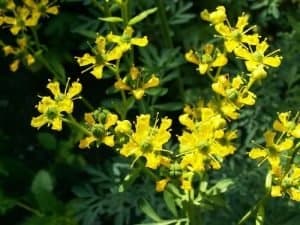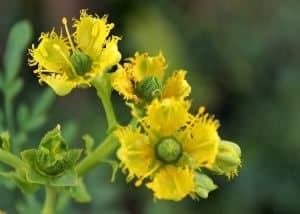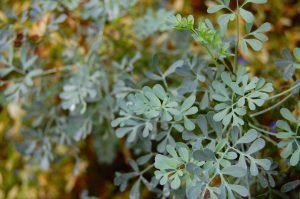What is Rue Plant?
Rue (Ruta Graveolens) consider as an old-fashion herb garden plant. If grown for medical reasons (which studies have shown to be mostly ineffective and dangerous), rue plants are rarely grown in the garden these days.
Centuries ago, before everything herbal became a trend, people grew as a medicinal plant. Rue is a mysterious plant with broad uses and different applications: it has been used as a witchcraft ingredient and additive for holy water. It is known as a flea repellent and a popular condiment for sausages and fish. Even if you don’t explore the herbal uses of this strong-smelling plant, you will understand how its summer flowers attract butterflies and beneficial parasitic wasps to the garden. When not in bloom, the small bluish-green foliage is a fantastic resource in the flower and herb garden.

Scientific Classification of Rue Plant
Kingdom: Plantae
Order: Sapindales
Family: Rutaceae
Subfamily: Rutoideae
Genus: Ruta
Rue Varieties
‘Jackman’s Blue’ Rue
Jackman’s blue Rue is also known as Ruta graveolens or an herb of grace. It is famous for its aromatic green-blue foliage and small yellow flowers. It is considered the national plant of Lithuania, where it is associated with the virginity and virginity of girls. Traditionally, it used to make crowns for brides that indicated their survival.
Ruta graveolens is planted as an ornamental plant in gardens. Slightly smaller than its counterpart Ruta Chalenpensis (Fringed Rue), Ruta graveolens composes of 2 to 3 blue-green leaves divided in a targeted way. Its yellow flowers characterize by a slight inflorescence, although its pedicels are as long as the capsule. The flower retains 4 to 5 finely toothed rounded petals.
Fringed Rue
The fringed Rue, more commonly known as Ruta Chalepensis, is mainly found in the Mediterranean region, as in Portugal. Because it is a hardy variety, it has spread across much of Europe and California to the United States. Within the Mediterranean region, you will find Rue fringed widely in rocky places such as the gorges of Crete, in mountainous and sub-mountainous areas, on dry coasts and piles and limestones.
It is a curious flower with four or five yellow petals with a scoop-like shape that blooms from April to June. The yellow flowers surrounded by the edges of long and fine hairs. When the leaves crushed, they emit a bitter and unpleasant smell. When the bush is flowerless, it is blue-gray. This perennial herb usually grows to 20-80 cm tall and has 10-20 cm leaves that are intermittent with oil glands.

How to Grow Rue Plant in your garden?
Rue plants have dense evergreen fern leaves. The flowers on the rue plant are yellow with petals that are curly at the edges, and the center of the flower is generally green. The Rue usually grows to a height of 2 to 3 feet tall. Rue flowers grow well in the sun, but partial shade tolerated.
https://www.youtube.com/watch?v=FTvqteosAN4
Growing Rue Plant From Seeds
Sometimes Rue plants self-seed in warm areas. In late summer, after flowering, you can collect brown seeds. Rue seeds need light to germinate, so don’t cover the seeds. Put them on wet soil and keep them at about 70 degrees Farenheight, so that germination takes place in one or three weeks.
Growing Rue Plant From Cutting
If you prefer to use cuttings, cut them in late summer. Avoid woody growth; look for mature green growth and take cuttings about 10 centimeters (4 inches) long. Put it in the sandy soil to hit, keeping the soil moist. Like seeds, bright shade is the best place as the roots are developing.
The root layers can excavate and transplant. You will see the roots develop as the stems come into contact with the soil. Once the root grows, you can transfer it to your desired place.
Caring of Rue Plant
- Waterless regularly, giving it a deep boost every two to three weeks. In the Balkan Peninsula and south-eastern Europe, it also grows in dry conditions in shallow and rocky soils.
- Cut the branches of the Rue in early spring, where the old dark-colored wood meets the new green growth. Cutting stimulates a dense, well growth.
- Remove and eliminate any leaves that begin to drip, color, or fall; this can be a sign of root rot, a fungal disease caused by excessive watering or soil that does not dry up fast enough. Also, remove the whole branches if all the leaves have fallen. Disinfect your drills with alcohol to spread the disease.
- Apply complete fertilizer with equal proportions of nitrogen, phosphorus, and potassium with Rue in early spring at the beginning of new growth. A typical amount of granular fertilizer is 2 pounds of fertilizer for every 1,000 square feet of soil.
- Throw organic mulch, such as straw or dry leaves, onto the ground around the delayed plant to protect it from freezing temperatures if you live in the northern parts of the Rue’s growing field.
Gardening Tips for Rue Plant
Although the Rue grows in poor soil in its native environment, it grows best with good garden soil rich in humus and organic matter. It prefers direct sunlight, but Rue also thrives in a light shade.
Uses of Rue Plant
Rue plant is mainly grown as medicinal herbs, and it has numerous uses as medicine form the middle ages. Some of the applications are listed below:
- The oil and fresh or dried leaves are widely in use for perfumes and foods.
- In the middle ages, the leaves of the plant are uses to dispel insects, scorpions, and serpents.
- The herb and oil are both uses as a “flavor component” in a wide variety of processed foods and beverages.
- It is useful to treat poor eyesight, wart, cancer, worms, and nervousness.
- In many cultures, Rue uses as a delay in menstrual periods and abortions, and some of its ingredients have been shown to have abortion properties.
- It used to ward off the plague and to cure people who suffered from witchcraft.
- The flavonoids such as rutin of Rue plant is useful to strengthen blood vessels and reduce blood pressure.
- Rue plants fresh leaves are useful to extract oil that possesses a strong, distinct odor.
- It is useful in the production of a wide range of soaps, fragrances, and beauty products.
Where can I buy Rue Plant?
You can find Rue Plant for sale on your local nurseries. You can also contact your local florists.

Amelia is a plant and nature lover! Ever since she was little, she loved spending time in her family’s garden and learning about how to care for each plant individually. As an adult, she has dedicated herself to sharing what she has learned and continuing to expand her knowledge on the plant kingdom.

